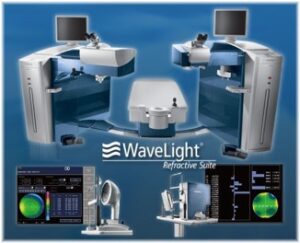By Prof. Somsanguan Asanyakhun
Head of LASIK Center Faculty of Medicine Chiang Mai University
Correction of myopia using laser light
Laser light is used to correct refractive errors in people who do not want to wear glasses or contact lenses. by changing the curvature of the cornea Causing the light to concentrate on the retina so the image can be seen clearly There are many ways The most popular treatments today are LASIK (LASIK = Laser In-situ Keratomileusis) and PRK (PRK = Photo-Refractive Keratectomy).
LASIK How is it done and how many types?
LASIK is a procedure that separates the top layer of the cornea into a flap and uses an Excimer laser to break up the middle layer of the cornea. To correct the curvature of the cornea, let the light concentrate exactly on the retina and then reattach the flap to cover it (Fig. 1).

There are two methods of separating the top layer of the cornea for flap.
1. ใช้ใบมีดขนาดเล็ก (microkeratome) (รูปที่ 2)

เรียกเลสิคแบบนี้ว่า MK LASIK ซึ่งเป็นเลสิคแบบดั้งเดิม
2. Femtosecond laser (FS laser) is used, so this type of LASIK is called femto LASIK or bladeless LASIK or LASIK. all laser LASIK (Fig. 3)

How is femtolasik better than blade lasik?
Femto lasik has been developed with several advantages over blade-based LASIK (MK LASIK) including being able to separate the top layer of the cornea (Flap) more smoothly, resulting in less incision. get well faster There is less chance of infection and dry eyes after surgery. get a clearer picture There are fewer flap complications. It has better accuracy in determining the thickness of the flap. In addition, the flap can be cut thinner, making it impossible for people with thin corneal thickness to have blade LASIK. Have a chance to have femto LASIK surgery safely.
However, Femto LASIK has its drawbacks. The most common concern with the FS laser is diffuse lamellar keratitis (DLK), which has been reduced with the newer, higher pulse rate FS laser. Faculty of Medicine Chiang Mai University uses FS 200 which is the highest pulse rate at present)
LASIK is different from PRK.
PRK (PRK) is an excimer laser used to dissolve corneal tissue without separating the top layer into a flap, but scraping the corneal surface first. It may be scraped with a blade. Or alcohol or laser (Figure 4) and put on contact lenses after about 1 week or until the wound heals.

The advantage of PRK is that it can be performed safely in people whose corneas are too thin to undergo Femto LASIK. But there are many drawbacks, for example, there is more eye pain after surgery. wound healing is slower Causing more chances of infection after surgery There is more fogging of the cornea, so it should not be done in people with eyesight greater than 4.00 diopter, etc.
Points to consider when making decisions about laser refractive correction
Laser vision correction This changes the curvature of the cornea so that light falls on the retina. therefore clearly visible without glasses or contact lenses Therefore, those who decide to do Should have stable eyesight for at least 1 year, no disease that affects wound healing, such as diabetes, autoimmune disease, etc., and must have a thorough eye examination that does not have eye diseases such as glaucoma, cataracts, the eyepiece. Alzheimer's, lazy eye, etc. In particular, the condition of the cornea must be analyzed to ensure that there are no contraindications to doing such as corneal bulging. (Keratoconus) Insufficient thickness of the cornea. have unevenness severe dryness of the cornea, etc.
Contact lens wearers must stop wearing before going for examination in order for the cornea to return to shape Depending on the type of lens as follows: Soft contact lens 1 week Soft toric lens 2 weeks Soft toric lens 1 month
On the day of the examination, sunglasses should be prepared. and someone took them back It requires dilatation of the pupils to assess the condition of the eye in detail. in which the amblyopia and Can't fight the light after dilation of the iris will take 3-6 hours, so it's not appropriate to drive back by yourself.
LASIK Center, Faculty of Medicine Chiang Mai University Which LASIK model do you use?
LASIK Center, Faculty of Medicine Chiang Mai University It has been in service since December 12, 2012 using a WaveLight Refractive Suit LASIK (Figure 5), which consists of a Femtosecond laser model FS 200 and an Excimer laser model EX 500 with signals from a Wavefront corneal analyzer. technology direct access to the machine through the WaveNet Computer Network ensures accurate and precise data.

LASIK Center, Faculty of Medicine Chiang Mai University Where is it located? how to contact
LASIK Center, Faculty of Medicine Chiang Mai University or CMU LASIK Center is located on the 8th floor of the Chaloem Phra Kiat Building 7th Cycle Birthday Anniversary. Faculty of Medicine (Area of the parking lot behind the gas station Opposite Maharaj Nakorn Chiang Mai Hospital) and provides care by a team of ophthalmologists. Cornea and Refractive Surgery Unit Department of Ophthalmology Faculty of Medicine Chiang Mai University
You can contact us for information at the LASIK Center, Faculty of Medicine. Chiang Mai University
Tel. 0-5393-9777 Call center 08-2766-6909 or www.facebook.com/cmulasik
